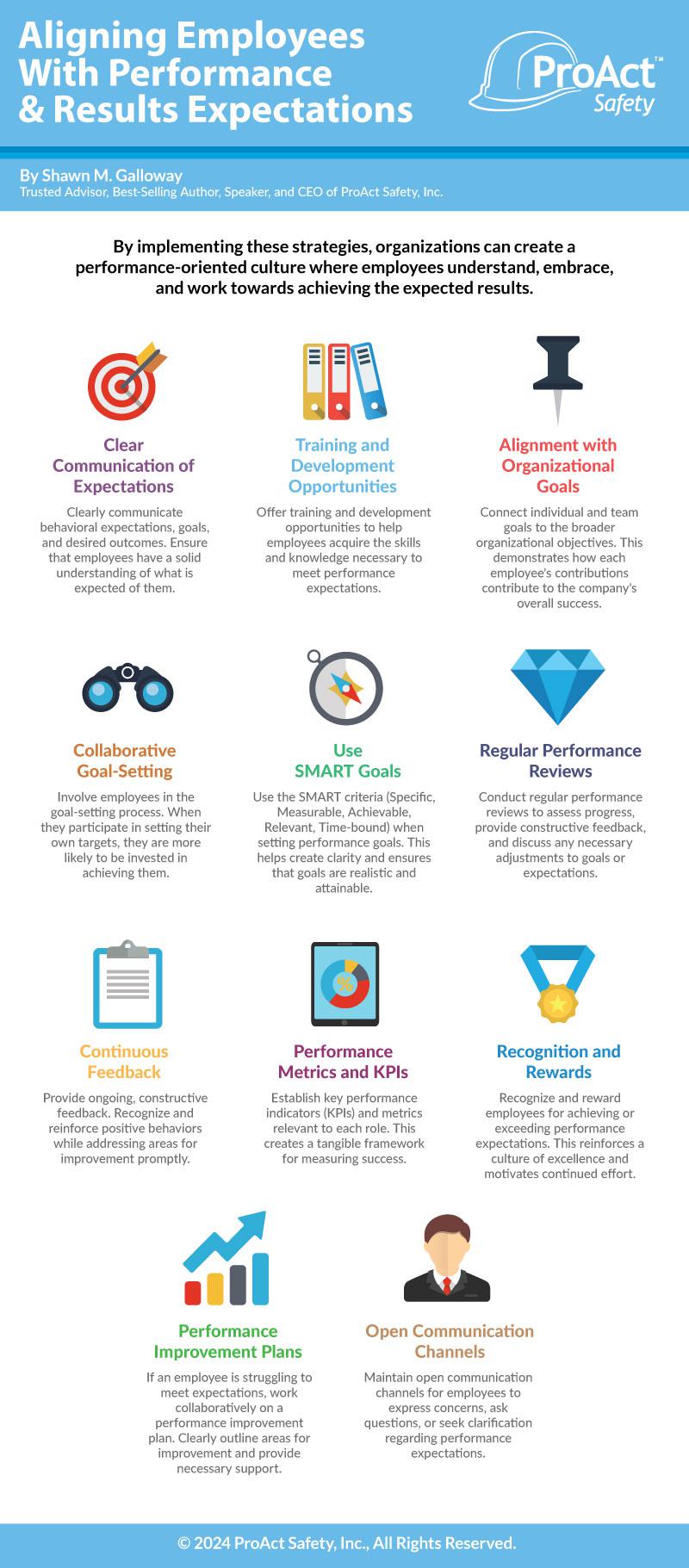April 22 2024
By: Shawn M. Galloway
Aligning employees with performance and results expectations is crucial for organizations seeking to achieve their goals and maintain a high level of productivity. By setting clear expectations and ensuring alignment, organizations can enhance employee engagement, improve performance, and drive overall success. Let us explore the importance of aligning employees with both performance and results expectations and the benefits this brings to organizations.
Clarity and Focus: Aligning employees with performance and results expectations provides clarity on what is expected of them. When employees clearly understand their roles and responsibilities, they can focus their efforts on achieving the desired outcomes. This clarity eliminates ambiguity and empowers employees to prioritize their tasks and make informed decisions that contribute to the organization's goals.
Motivation and Engagement: When employees understand how their efforts contribute to the overall results of the organization, they are more motivated and engaged in their work. Aligning performance and results expectations helps employees see the bigger picture and understand the impact of their individual contributions. This sense of purpose and connection to the organization's goals drives employee motivation, leading to increased productivity and job satisfaction.
Accountability and Ownership: When employees know what is expected of them and how their performance will be measured, they take responsibility for their work and outcomes. This accountability encourages employees to take ownership of their tasks, seek continuous improvement, and deliver high-quality results. When employees feel accountable, they are more likely to take initiative, collaborate, and find innovative solutions to challenges.
Performance Management and Development: Clear expectations allow managers to provide feedback, set goals, and support employees in achieving their targets. By aligning individual performance with organizational results, organizations can identify areas of improvement, provide targeted training and development opportunities, and ensure that employees are equipped with the skills and resources needed to succeed.
Team Collaboration and Cohesion: When everyone understands their role and how their contributions fit into the bigger picture, they can work together toward common objectives. This alignment encourages communication, coordination, and mutual support, leading to improved teamwork and synergy. Employees can leverage their diverse skills and expertise to achieve shared goals, resulting in increased productivity and overall team success.
By implementing the following strategies, organizations can create a performance-oriented culture where employees understand, embrace, and work towards achieving the desired results.
Clear Communication of Expectations: Clearly communicate behavioral expectations, goals, and desired outcomes. Ensure that employees have a solid understanding of what is expected of them.
Collaborative Goal-Setting: Involve employees in the goal-setting process. When they participate in setting their own targets, they are more likely to be invested in achieving them.
SMART Goals: Use the SMART criteria (Specific, Measurable, Achievable, Relevant, Time-bound) when setting performance goals. This helps create clarity and ensures that goals are realistic and attainable.
 Regular Performance Reviews: Conduct regular performance reviews to assess progress, provide constructive feedback, and discuss any necessary adjustments to goals or expectations.
Regular Performance Reviews: Conduct regular performance reviews to assess progress, provide constructive feedback, and discuss any necessary adjustments to goals or expectations.
Continuous Feedback: Provide ongoing, constructive feedback. Recognize and reinforce positive behaviors while addressing areas for improvement promptly.
Performance Metrics and KPIs: Establish key performance indicators (KPIs) and metrics relevant to each role. This creates a tangible framework for measuring success.
Training and Development Opportunities: Offer training and development opportunities to help employees acquire the skills and knowledge necessary to meet performance expectations.
Recognition and Rewards: Recognize and reward employees for achieving or exceeding performance expectations. This reinforces a culture of excellence and motivates continued effort.
Performance Improvement Plans: If an employee is struggling to meet expectations, work collaboratively on a performance improvement plan. Clearly outline areas for improvement and provide necessary support.
Alignment with Organizational Goals: Connect individual and team goals to broader organizational objectives. This demonstrates how each employee's contributions contribute to the company's overall success.
Open Communication Channels: Maintain open communication channels for employees to express concerns, ask questions, or seek clarification regarding performance expectations.
Aligning employees with performance and results expectations is essential for organizations to drive success and maintain a high level of productivity. By providing clarity, motivation, and accountability, organizations can foster a culture of engagement, ownership, and continuous improvement. Moreover, aligning individual performance with organizational results enhances performance management, development, and team collaboration. Organizations that prioritize alignment of employee expectations with performance and results will reap the benefits of increased productivity, employee satisfaction, and overall success.
"Our environment, the world in which we live and work, is a mirror of our attitudes and expectations." — Earl Nightingale
"Don't lower your expectations to meet your performance. Raise your level of performance to meet your expectations. Expect the best of yourself, and then do what is necessary to make it a reality." — Ralph Marston
"If you are building a culture where honest expectations are communicated and peer accountability is the norm, then the group will address poor performance and attitudes." — Henry Cloud

Shawn M. Galloway is the CEO of ProAct Safety and an advisor to leading organizations across all major industries. With over twenty years of experience in safety systems, strategy, culture, leadership, and employee engagement, he is a trusted advisor, keynote speaker, and expert witness.
He is the author of several bestselling books and has multiple regular columns in leading magazines, with over 400 articles and 100 videos to his credit. He also created the first safety podcast, Safety Culture Excellence, with over 800 episodes. Shawn has received numerous prestigious accolades and has been featured in Power 101 Leaders of the EHS World, Top 50 People Who Most Influenced EHS, Top 40 Rising Stars, Top 11 Health and Safety Influencers, and Top 10 Speakers.
He serves on the Harvard Business Review Advisory Council and the Fast Company Executive Board. He has appeared as a guest on Bloomberg, Fox News, The Daily Mail, Dubai One, U.S. News & World Report, Sirius Business Radio, Wharton Business Daily, and leading safety magazines and podcasts, reinforcing his status as an authority in the field of safety excellence.
For more information, call +1.936.273.8700 or email info@ProActSafety.com.
